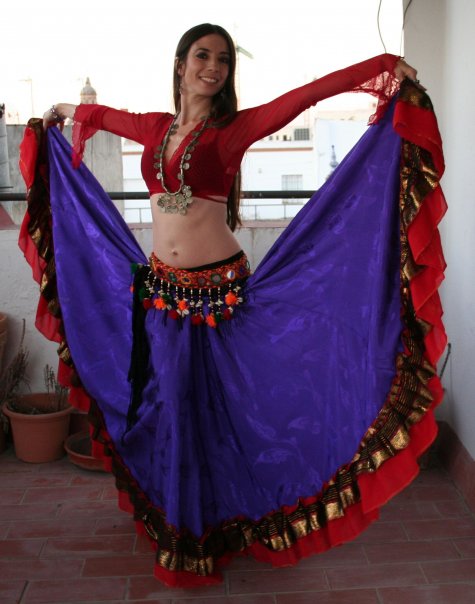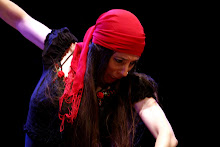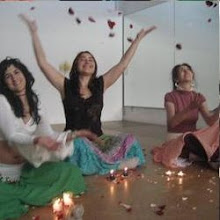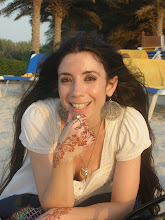Ana Dancing in Kuwait

Ana Otero (Madrid, Spain)
Ana Otero (Madrid, Spain)
PHD Dance Ethnologist
As long as Ana can remember, dance has always been a part of Ana’s life. At an early age she started studying classical ballet, Flamenco and Spanish Dance in Madrid. Ana Otero later went to University in Miami to study Dance and Literature.
At university she met Miriam Eli and enrolled in her Middle Eastern Dance class at Florida International University. Ana considers Miriam as her soul teacher because not only did she learn the beautiful and complicated technique of this dance from her, but also its history. Miriam also taught her the importance of folklore in the Arab world and introduced her to sufism and Persian Sacred Dances.


After University she went back to Madrid, Spain. She immediately was hired to perform in Poland with the Theatre company Lomvriz. After touring Poland she decided to settle in her home town Madrid and focus on teaching. She taught in Escuela de Baile El Horno in Madrid. In her journey as a dance teacher and choreographer, she taught Flamenco and Middle Eastern Dance. She eventually developed a style wich she called Duendel Dance which was a fusion of Contemporary, Flamenco and Oriental/Gypsy Dance forms. She later met Shokry Mohammed (Egypt) and studied in his Middle Eastern Dance School (Escuela de Danza Oriental Pirámides) for 4 years. There she studied Classical Egyptian, Raqs Sharki, as well as Turkish styles and Persian Sacred Dances. Shokry and Ana began a journey which they called Al Andalus, having Ana a Flamenco backround, both of their passions became to reinvent the dance of Al Andalus, the dance in Spain as danced by the muslims, jews, christians and gypsies living together in perfect harmony. Ana soon became a dancer in his company and performed in Shokry Mohammed's theatrical shows throughout Spain. Her interest in Oriental dance has taken her to Turkey to study Turkish Gypsy Dance and to Cairo.


Ana slowly started working towards her PHD in Dance Ethnology, which she happily finished, and soon realised that inside of her dance studios, her students found a home, they found a comfort, and she started to teach dance on a more spiritual level. Ana believes that through dance not only do we acquire a sense of wholeness and happiness, but we also become more aware of our bodies. She started incorporating a yoga (Ana is a certified yoga instructor) based workout, breathe and movement synchronization exercises and meditation. Soon, her dance class was more than technique and choreography, it became a spiritual awakening for her students and herself.


Ana has lived and taught in Egypt, Kuwait and Dubai. She has learned from many masters from the Arab world and from India.


Many of Ana's masters: Cristiane Azem, Eva Chacón, Julia Salmerón, Gloria Alba, Tatiana, Mahmoud Reda, Rakia Hassan, Nabil Mabrouk, Fátima Fontes, Myriam Szabo, Souhaila Salimpour, Tito and Ansuya, Bettinal Castano, Manuela Reyes, Belen Maya, Faruk Mustafa, Mona Mustafa, Nasra, Freiz, Sameh el Dessouki, Ashraf Hassan, Chua Alba, Manolete, Judea Maya, Isabel Bayón, Rafael Campallo, Raquel Molina.
Ana and yoga:
Ana Otero received her first certification with Swami Sivananda and lived in the Sivananda Ashram in Zaragoza, Spain, for three months. She later received the European Association of Yoga Degree (3 year degree). Her great Masters in Spain have been Ramiro Calle and Margot Paccuad, and she has studied with many other Masters from the United States and India. She has also taken workshops with different masters around the world. Ana teaches a variety of styles: Hatha, Iyengar,Ashtanga, Jivamukti (a mix of these 3), Vinyasa and Kundalini. She has also created a new yoga philosophy which she calls Kundalini Shakti Dance, which is a fusion of yoga and dance, the main objective being to wake up the Kundalini energy which lies dormant in the base of the spine and to balance out the chakras. This Dance, just as in yoga, is centered in the breathing. Movement and breath synchronizing to create the state of a moving meditation.
Ana's yoga classes focus on Mind, Body and Spirit working in unison throughout the practise. Her warm up exercises in class consist of Pranayama Breathing and Kundalini practise to warm up the spine. At the end of each session she places great importance on savasana, relaxation, and offers a reiki message to her students.www.anaoteroyoga.blogspot.com
In addition to my artistic vision of dance and to my artistic needs as a performer, I am now keenly interested in the therapeutic and life-saving powers of dance and I want to help dancers and people in general to “Dance the Dance of Life!” I work with students, not only to improve technique and skill, but to travel into their inner spirit to get to the ‘soul of the dance’ . I use dance to express emotion, have fun, build strength and confidence, to improve physical and emotional health and ultimately, send out positive energy and beauty into the world.
Ana Otero

PHD Dance Ethnologist
As long as Ana can remember, dance has always been a part of Ana’s life. At an early age she started studying classical ballet, Flamenco and Spanish Dance in Madrid. Ana Otero later went to University in Miami to study Dance and Literature.
At university she met Miriam Eli and enrolled in her Middle Eastern Dance class at Florida International University. Ana considers Miriam as her soul teacher because not only did she learn the beautiful and complicated technique of this dance from her, but also its history. Miriam also taught her the importance of folklore in the Arab world and introduced her to sufism and Persian Sacred Dances.
After University she went back to Madrid, Spain. She immediately was hired to perform in Poland with the Theatre company Lomvriz. After touring Poland she decided to settle in her home town Madrid and focus on teaching. She taught in Escuela de Baile El Horno in Madrid. In her journey as a dance teacher and choreographer, she taught Flamenco and Middle Eastern Dance. She eventually developed a style wich she called Duendel Dance which was a fusion of Contemporary, Flamenco and Oriental/Gypsy Dance forms. She later met Shokry Mohammed (Egypt) and studied in his Middle Eastern Dance School (Escuela de Danza Oriental Pirámides) for 4 years. There she studied Classical Egyptian, Raqs Sharki, as well as Turkish styles and Persian Sacred Dances. Shokry and Ana began a journey which they called Al Andalus, having Ana a Flamenco backround, both of their passions became to reinvent the dance of Al Andalus, the dance in Spain as danced by the muslims, jews, christians and gypsies living together in perfect harmony. Ana soon became a dancer in his company and performed in Shokry Mohammed's theatrical shows throughout Spain. Her interest in Oriental dance has taken her to Turkey to study Turkish Gypsy Dance and to Cairo.


Ana slowly started working towards her PHD in Dance Ethnology, which she happily finished, and soon realised that inside of her dance studios, her students found a home, they found a comfort, and she started to teach dance on a more spiritual level. Ana believes that through dance not only do we acquire a sense of wholeness and happiness, but we also become more aware of our bodies. She started incorporating a yoga (Ana is a certified yoga instructor) based workout, breathe and movement synchronization exercises and meditation. Soon, her dance class was more than technique and choreography, it became a spiritual awakening for her students and herself.
Ana has lived and taught in Egypt, Kuwait and Dubai. She has learned from many masters from the Arab world and from India.


Many of Ana's masters: Cristiane Azem, Eva Chacón, Julia Salmerón, Gloria Alba, Tatiana, Mahmoud Reda, Rakia Hassan, Nabil Mabrouk, Fátima Fontes, Myriam Szabo, Souhaila Salimpour, Tito and Ansuya, Bettinal Castano, Manuela Reyes, Belen Maya, Faruk Mustafa, Mona Mustafa, Nasra, Freiz, Sameh el Dessouki, Ashraf Hassan, Chua Alba, Manolete, Judea Maya, Isabel Bayón, Rafael Campallo, Raquel Molina.
Ana and yoga:
Ana Otero received her first certification with Swami Sivananda and lived in the Sivananda Ashram in Zaragoza, Spain, for three months. She later received the European Association of Yoga Degree (3 year degree). Her great Masters in Spain have been Ramiro Calle and Margot Paccuad, and she has studied with many other Masters from the United States and India. She has also taken workshops with different masters around the world. Ana teaches a variety of styles: Hatha, Iyengar,Ashtanga, Jivamukti (a mix of these 3), Vinyasa and Kundalini. She has also created a new yoga philosophy which she calls Kundalini Shakti Dance, which is a fusion of yoga and dance, the main objective being to wake up the Kundalini energy which lies dormant in the base of the spine and to balance out the chakras. This Dance, just as in yoga, is centered in the breathing. Movement and breath synchronizing to create the state of a moving meditation.
Ana's yoga classes focus on Mind, Body and Spirit working in unison throughout the practise. Her warm up exercises in class consist of Pranayama Breathing and Kundalini practise to warm up the spine. At the end of each session she places great importance on savasana, relaxation, and offers a reiki message to her students.www.anaoteroyoga.blogspot.com
In addition to my artistic vision of dance and to my artistic needs as a performer, I am now keenly interested in the therapeutic and life-saving powers of dance and I want to help dancers and people in general to “Dance the Dance of Life!” I work with students, not only to improve technique and skill, but to travel into their inner spirit to get to the ‘soul of the dance’ . I use dance to express emotion, have fun, build strength and confidence, to improve physical and emotional health and ultimately, send out positive energy and beauty into the world.
Ana Otero
domingo, 12 de abril de 2009
Flamenco
The origins of flamenco are one of those hotly debated issues which I don't think anyone can really prove. Certainly it was influenced by moorish/eastern dance, spanish dances, and it's greatest proponents were probably the gypsies. They may have even been some cross- influence of flamenco back into Turkish and other Middle Eastern dances. None of this is that clear-cut and proven. Despite all the 'Moorish' dance interpretations you will see, there's very little info on what these actually looked like - there is a 'Moorish' style of flamenco dance that hints at what it might have been - it's performed barefoot (Zambra).
Flamenco is a generic term applied for the body of music, song and dance normally associated with Andalusian Gypsies . In the broader sense, flamenco is the Andalusian folk art of the poor. The word is also used to describe a flamenco performer or aficionado.
It evolved from a combination of Gypsy and non-Gypsy cultural influences. In the 9th century for example, a musician from Baghdad called Zyryab founded a singing school in Cordoba. He was largely responsible for adding Persian music and poetry to Andalusian culture. Later influences included the Gregorian musical system of the Christians and possibly the liturgical music of the Jews .
The first time Flamenco is reported on in literature is in the "Cartas Marruecas" of Cadalso, in 1774.Between 1765 and 1860, the first Flamenco-schools were created: Cádiz, Jerez de la Frontera and Triana (Seville).In this epoch Flamenco dance started to have its firm position in the ballrooms. Early Flamenco seems to have been purely vocal, accompanied only by rhythmical clapping of hands, toque de palmas. It was left to dedicated composers, as Julián Arcas, to introduce guitar playing.
During its Golden Age (1869-1910) Flamenco was developed in the epoch's numerous music cafés (cafés cantantes) to its definitive form. Also the more serious forms expressing deep feelings (cante jondo) dates from then.
Flamenco dance arrived to its climax, being the major attraction for the public of those cafés cantantes. Guitar players featuring the dancers increasingly gained a reputation.
The time from 1910 to 1955 Flamenco singing is marked by the ópera flamenca, with an easier kind of music such as fandangos and cantes de ida y vuelta. The latter clearly showed South American influences.
From 1915 on Flamenco shows were organized and performed all over the world. Anyhow, not everybody was enchanted with that development and intellectuals such as Falla organized in 1922 in Granada a contest to promote "authentical" cante jondo.
1955 started a sort of Flamenco Renaissance, the great performer Antonio Mairena being its key figure. Outstanding dancers and soloists soon made their way out of the small tablaos, successors to the early cafés cantantes, to the great theaters and concert houses. It was now that guitar players acquired a great protagonism, and their playing arrived to masterity.
Actual Flamenco frequently shows influences of other kinds of music, as Jazz, Salsa, Bossa Nova, etc.
Also Flamenco dance has changed, specially female dancers try to rather showcase their temperament than artistry. The Flamenco guitar that formerly was just featuring the dancers arrived to be a soloistical art form, great virtuoso Paco de Lucia being the pioneer of that development."
Flamenco is a way of life, a philosophy of life, I will always be a flamenca…
When I discovered Oriental Dance I was absolutely mesmerized, I became addicted to the importance given to the dancer’s spirit, how the dancer must be absolutely transparent to show his / her emotions.
I remember when I took my first Class with Myriam Eli at Florida International University, where I studied dance. After a semester of intense research and dance we had our exam which consisted of three parts: 1. Choreography 2. Research paper, and 3: Improvisation .
I took my fellow classmates by surprise when I improvised. I got so into the music that my “duende” awoke from deep inside and since our bodies also have a memory, I started to naturally fuse Oriental Dance with Flamenco…
After class this older woman who was signed up in the course approached me and said: “Ana, you must pursue this, the duende is exactly what oriental dance lacks, and the free flow movement is what flamenco lacks…
That was the beginning of my relationship with Flamenco Arabic fusion. This fusion later took me to study Katak, Baratanatyam and Odyssey, three forms of Indian dance where there is an obvious connection to Flamenco dance.
Flamenco is a generic term applied for the body of music, song and dance normally associated with Andalusian Gypsies . In the broader sense, flamenco is the Andalusian folk art of the poor. The word is also used to describe a flamenco performer or aficionado.
It evolved from a combination of Gypsy and non-Gypsy cultural influences. In the 9th century for example, a musician from Baghdad called Zyryab founded a singing school in Cordoba. He was largely responsible for adding Persian music and poetry to Andalusian culture. Later influences included the Gregorian musical system of the Christians and possibly the liturgical music of the Jews .
The first time Flamenco is reported on in literature is in the "Cartas Marruecas" of Cadalso, in 1774.Between 1765 and 1860, the first Flamenco-schools were created: Cádiz, Jerez de la Frontera and Triana (Seville).In this epoch Flamenco dance started to have its firm position in the ballrooms. Early Flamenco seems to have been purely vocal, accompanied only by rhythmical clapping of hands, toque de palmas. It was left to dedicated composers, as Julián Arcas, to introduce guitar playing.
During its Golden Age (1869-1910) Flamenco was developed in the epoch's numerous music cafés (cafés cantantes) to its definitive form. Also the more serious forms expressing deep feelings (cante jondo) dates from then.
Flamenco dance arrived to its climax, being the major attraction for the public of those cafés cantantes. Guitar players featuring the dancers increasingly gained a reputation.
The time from 1910 to 1955 Flamenco singing is marked by the ópera flamenca, with an easier kind of music such as fandangos and cantes de ida y vuelta. The latter clearly showed South American influences.
From 1915 on Flamenco shows were organized and performed all over the world. Anyhow, not everybody was enchanted with that development and intellectuals such as Falla organized in 1922 in Granada a contest to promote "authentical" cante jondo.
1955 started a sort of Flamenco Renaissance, the great performer Antonio Mairena being its key figure. Outstanding dancers and soloists soon made their way out of the small tablaos, successors to the early cafés cantantes, to the great theaters and concert houses. It was now that guitar players acquired a great protagonism, and their playing arrived to masterity.
Actual Flamenco frequently shows influences of other kinds of music, as Jazz, Salsa, Bossa Nova, etc.
Also Flamenco dance has changed, specially female dancers try to rather showcase their temperament than artistry. The Flamenco guitar that formerly was just featuring the dancers arrived to be a soloistical art form, great virtuoso Paco de Lucia being the pioneer of that development."
Flamenco is a way of life, a philosophy of life, I will always be a flamenca…
When I discovered Oriental Dance I was absolutely mesmerized, I became addicted to the importance given to the dancer’s spirit, how the dancer must be absolutely transparent to show his / her emotions.
I remember when I took my first Class with Myriam Eli at Florida International University, where I studied dance. After a semester of intense research and dance we had our exam which consisted of three parts: 1. Choreography 2. Research paper, and 3: Improvisation .
I took my fellow classmates by surprise when I improvised. I got so into the music that my “duende” awoke from deep inside and since our bodies also have a memory, I started to naturally fuse Oriental Dance with Flamenco…
After class this older woman who was signed up in the course approached me and said: “Ana, you must pursue this, the duende is exactly what oriental dance lacks, and the free flow movement is what flamenco lacks…
That was the beginning of my relationship with Flamenco Arabic fusion. This fusion later took me to study Katak, Baratanatyam and Odyssey, three forms of Indian dance where there is an obvious connection to Flamenco dance.
Suscribirse a:
Entradas (Atom)